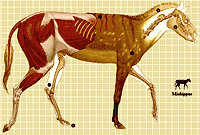 Navicular Syndrome in Horses Navicular Syndrome in Horses
By: Sarah Probst
Information Specialist
University of Illinois
College of Veterinary Medicine
"Navicular syndrome-a type of lameness that typically occurs in middle-aged Quarter
Horses and Thoroughbred males-is almost always bilateral in the forelimbs," says Dr.
Martin Allen, an equine veterinarian at the University of Illinois Veterinary Teaching
Hospital in Urbana. That means it affects both front legs, rather than appearing in only one.
Factors that contribute to navicular syndrome are preferentially breeding for large body
mass and small feet, poor conformation, and poor or inappropriate shoeing practices that
lead to a broken hoof-pastern axis, long toes, and underslung heels. "All of the above can
place abnormal forces on the navicular bone, causing inflammation, pain, increased pressure in the bone, and ultimately lameness," explains Dr. Allen.
Many lamenesses induce obvious signs, such as head nodding or limping. Because navicular syndrome does not induce head bobbing initially, the disease often progresses to its chronic stage before it is caught. "When I examine a horse with any sort of lameness, the first thing I do is look at the horse and walk around it," says Dr. Allen. "With navicular syndrome, the horse may stand with one or both feet planted slightly more forward than neutral to relieve pressure."
During the examination, Dr. Allen asks the owner questions to complete a case history. The physical examination involves applying pressure to the hoof with hoof-testers. "In navicular syndrome, the horse will be sensitive to hoof-tester pressure over the central third of the frog," explains Dr. Allen.
"Another step in diagnosing navicular syndrome is to watch the horse in motion. When you circle horses with navicular syndrome to the right, they are more lame on the right and when you circle them to the left, they become more lame on the left," says Dr. Allen.
Veterinarians may also use a nerve block to diagnose this disease. If one leg is more painful than the other, it is often difficult to tell if the less painful leg is lame too, because the horse may only appear lame on the more painful side. "We block the nerves on the more painful leg to eliminate the lameness on that side. Without that pain, horses with bilateral navicular syndrome will then appear lame on the less painful leg," explains Dr. Allen.
Radiographs (X rays) can also be helpful with diagnosis. "You can't diagnose navicular
syndrome from radiographs alone, however," says Dr. Allen. "Radiographic changes
specific to navicular syndrome, viewed along with results of other tests, may suggest that
diagnosis."
Nuclear bone scan is another imaging modality that may help determine a diagnosis. A low
dose of a safe radioactive material is injected into the horse to detect areas of bone
remodeling called "hot spots." If a horse has navicular syndrome, increased uptake of the
radioactive material will indicate activity at that site.
"You generally cannot cure or reverse navicular syndrome, but you can manage it," says Dr. Allen. "Our goals are to reduce inflammation, remove pain from soft tissue, increase
pliability, increase blood supply, and align the hoof-pastern axis to improve the gait of the
horse." Most of this is accomplished with specific drugs, corrective trimming, corrective
shoeing, and controlled exercise.
Corrective shoeing aligns the hoof-pastern axis to establish good lateral-to-medial balance
in the leg. "With navicular syndrome, we generally choose egg bar shoes to achieve good
heel support. We will also square or roll toes to ease break-over in the stride. To promote
heel expansion and relieve pressure on the navicular area during weight bearing, we choose not to place any nails past the widest part of the foot," says Dr. Allen.
In most cases such therapy allows horses with navicular syndrome to live more comfortably and return to a certain level of function. If therapy does not help, a neurectomy can be performed as a last resort. This is done in intractable cases when a nerve block has been shown to significantly improve gait; it involves cutting the nerves to the navicular area. "Owners should know that this treatment is not without possible short- and long-term complications," says Dr. Allen, "such as undetected foot abscesses or nail punctures, painful nodules on the cut nerve (neuromas), and even tendon rupture."
For more information about lameness, contact your local equine veterinarian.
CEPS / 2938 VMBSB
2001 S Lincoln Ave / Urbana, Illinois 61802-6199 / Phone: 217/333-2907
Your comments about the site are welcome, but we cannot dispense medical advice via the Internet.
Reprinted with permission from the University of Illinois, College of Veterinary Medicine |